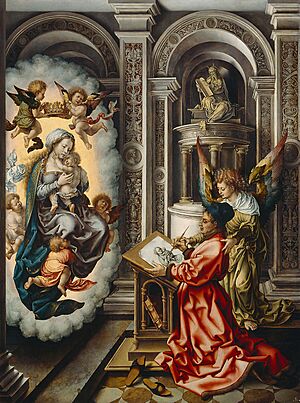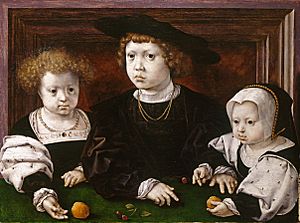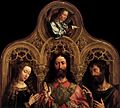Jan Gossaert facts for kids
Jan Gossaert (born around 1478 – died October 1, 1532) was an important painter from the Low Countries, which is now Belgium and the Netherlands. He was also known as Jan Mabuse, a name he took from his hometown, Maubeuge.
Gossaert was one of the first artists from his region to travel to Italy and Rome. He went there in 1508–09. This trip greatly influenced his art. He became a leader of a style called Romanism. This style brought ideas from Italian Renaissance painting to northern Europe. He became famous across Europe for his religious paintings, large altarpieces, portraits, and mythological scenes.
From about 1508, he worked for powerful families, mostly members of the Habsburg family. These included Philip of Burgundy and Adolf of Burgundy. He also painted for Christian II of Denmark when he was in exile.
Gossaert lived at the same time as famous artists like Albrecht Dürer and Lucas van Leyden. While he was well-known in his time, he is sometimes less recognized today than these other artists. He did not make prints, but his drawings are considered very beautiful.
Contents
About Jan Gossaert's Life
Jan Gossaert's real name was "Jan Gossart." The name "Gossaert" became common later. We don't know much about his early life. Some historians believe he was from Maubeuge. Others think he was the son of a bookbinder and trained at Maubeuge Abbey. There is also some evidence he was born in Duurstede Castle. He joined the artists' guild in Antwerp in 1503.
Travel to Italy
In 1508-1509, Gossaert traveled to Rome. He went with Philip of Burgundy, who was an ambassador to the Pope. Philip's group arrived in Rome in January 1509 and returned to the Netherlands by June 1509. Gossaert likely stayed with Philip until Philip died in 1524. Philip later became the Bishop of Utrecht. Even while working for Philip, Gossaert could take on other jobs for Philip's friends.
Working for Important People
From 1509 to 1517, Gossaert lived in Middelburg. People said he was one of the first Flemish artists to bring the "Italian style" of painting back home. From 1517 to 1524, he lived at Duurstede Castle. During this time, Jan van Scorel was one of his students. After 1524, Gossaert returned to Middelburg. He became the court painter for Adolf of Burgundy, another relative of the Habsburg family. Jan Mertens the Younger was also one of his students.
Gossaert was influenced by older artists like Rogier van der Weyden. Like Van der Weyden, Gossaert often placed his figures in detailed architectural settings.
Famous Artworks by Gossaert

Gossaert's paintings show influences from Antwerp. His large altarpieces, like the one once at Castle Howard, are good examples. He also painted a famous altarpiece called Descent from the Cross for a church in Middelburg. The famous artist Albrecht Dürer admired this work. Sadly, the church and possibly the altarpiece were later destroyed by lightning.
The Adoration of the Kings
One of his most famous paintings is The Adoration of the Kings. This painting was made for a monastery and is now at the National Gallery in London. It shows about thirty figures in a detailed architectural setting. Gossaert used bright costumes and strong color contrasts in this work. His figures often look solid and traditional, like chess pieces. The landscapes in his paintings often show towers and steeples, similar to the style of Van der Weyden.
Influence of Italy
When Gossaert went to Italy in 1508, it changed art in the Netherlands. He studied the works of Italian artists. He brought a new style back home. He also started a trend: after him, many Flemish painters felt they needed to visit Italy. This mix of Italian and Flemish styles sometimes made Flemish art lose some of its unique qualities for a while.
Gossaert made many drawings in Rome, sketching ancient ruins and sculptures. Only a few of these drawings still exist today. They include sketches of the Colosseum and famous statues like the "thorn extractor" (Spinario).
Later Works and Portraits
After returning from Italy, Gossaert continued to work for important people. He painted a portrait of Eleanor of Portugal and other small pieces for Charles V in 1516.
Some of his signed works from this time include Neptune and Amphitrite (1516) in Berlin and a Madonna with a portrait of Jean Carondelet (1517) at the Louvre. While some of his mythological figures, like Neptune and Amphitrite, might seem a bit unusual, Gossaert was capable of creating beautiful and powerful art.
His painting St Luke painting the portrait of the Virgin (in Prague and Vienna) shows his skill. In these works, his figures still look strong, and his architecture is rich. He started using softer, cooler colors, like the sfumato style from Milan. When he used bright colors, he combined them with smooth surfaces and clear outlines. Good examples of this are his Madonnas in Munich and Vienna (1527), a girl weighing gold pieces (Berlin), and the portraits of the children of the King of Denmark at Hampton Court.
In 1523, Christian II of Denmark asked Gossaert to paint his children: John, Dorothy, and Christine. These portraits are now at Hampton Court. For a long time, people thought these were portraits of English royalty, but they are actually the Danish children.
Gossaert lived in Middelburg during this time. He also spent time at Duurstede Castle when Philip of Burgundy became bishop there. Gossaert helped decorate Philip's new palace. After Philip died in 1524, Gossaert designed his tomb. Gossaert then returned to Middelburg and worked for Philip's brother, Adolph.
Some stories say Gossaert lived a wild life, but his many surviving paintings show he was a very hardworking artist. He also had a family; his daughter married a painter named Henry van der Heyden. Gossaert died in Antwerp.
Images for kids
-
Christ between the Virgin and Saint John the Baptist, Prado Museum, Madrid.
See also
 In Spanish: Mabuse para niños
In Spanish: Mabuse para niños













